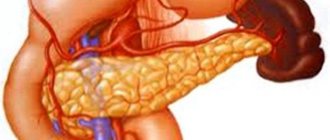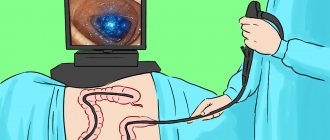Digestive function plays a very important role in the human body. Nutrition of all organs and systems depends on proper functioning. All food eaten is absorbed only in a liquid state, so the production of enzymes that break down foods plays an important role. Many pathological processes lead to disruptions in the functioning of digestion. With such diseases, a person begins to experience the feeling that food is not digested. If discomfort occurs regularly, it is recommended to consult a gastroenterologist as soon as possible. In some situations, treatment can be carried out using traditional methods. For severe illnesses, drug therapy is required.
Causes of vomiting
- consumption of poor quality food - the body is poisoned by toxic substances that enter the body with food;
- gastritis and gastric ulcer;
- disease of the pancreas and gall bladder;
- gag reflex after eating in stressful situations - due to a nervous disease;
- binge eating;
- drinking significant amounts of alcohol;
- stomach reaction to taking certain medications;
- the presence of a volumetric process in the stomach;
- acute appendicitis, accompanied by abdominal pain, nausea and vomiting;
- diseases of the central nervous system - volumetric process or brain injury;
- the first months of pregnancy;
- diseases of the vestibular apparatus - “motion sickness” when driving in transport;
- viral infections;
- helminthic infestations;
- chemotherapy for cancer.
Rare attacks of the gag reflex that occur when overeating or consuming any foods require mandatory adjustments to the diet. But if the stomach does not accept high-quality food, after eating which nausea appears, and then a gag reflex, this is a direct indicator for contacting a doctor. It is necessary to find out the cause of this phenomenon and carry out treatment.
Important! Vomiting after eating, which becomes systematic, is a symptom signaling a disease of the digestive system. A mandatory examination by a gastroenterologist is necessary to exclude diseases of the stomach or intestines.
What food should remain undigested?
Plant foods contain two types of fiber: digestible and indigestible. The first type should not remain in the feces in the form of fragments. If this does happen, it indicates that the stomach is not producing enough hydrochloric acid. The same can be said if the excrement contains almost whole pieces of vegetables and fruits. But the bran, peel, seeds, partitions, and stem fibers contain indigestible fiber. It is found in the coarsest parts of plants, covered with a double shell and consisting of cellulose and lignin and incapable of digestion in the human stomach.
So the detection of fragmentary remains of indigestible fiber in the stool does not indicate pathology, it is a physiological phenomenon.
Characteristics of vomit
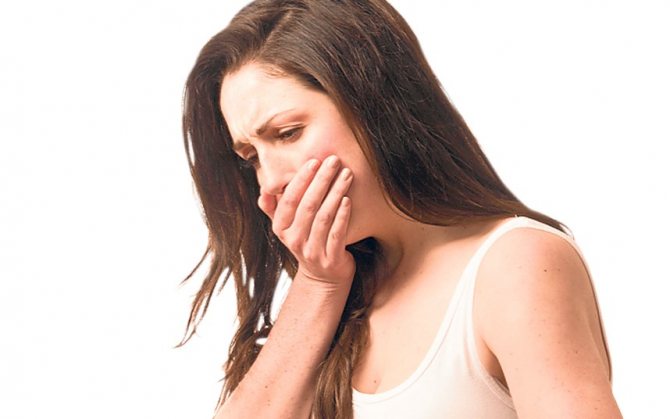
An important indicator of the state of the digestive system is the characteristics of vomit, by the nature of which the doctor can already determine a preliminary diagnosis. Vomit, depending on the disease, can be:
- with streaks of fresh blood - such a clinical picture is given by gastric bleeding, due to a rupture of a blood vessel during a peptic ulcer, a malignant tumor of the stomach, cirrhosis of the liver, polyps, as a complication during treatment with hormonal drugs. This is an acute condition that threatens the patient’s life and requires immediate hospitalization of the patient;
- dark-colored vomit - vomiting occurs when there are problems in the absorption of certain dark-colored foods or medications, for example, activated carbon. It is quite rare. Sometimes the dark color of the vomit is a reaction to general anesthesia;
- vomit of undigested food - typical for food poisoning, allergic reactions to a food allergen;
- vomit mixed with bile - characteristic of cholecystitis and pancreatitis;
- the natural color of gastric contents is characteristic of overeating, or if the gag reflex is provoked by a stressful situation.
Is this a pathology or a variant of the norm?
Each of us knows firsthand about changes in the color, smell and consistency of stool, because everyone experiences indigestion, infections, and constipation at least once in their lives. But undigested food fragments can cause real panic in some. Under normal conditions, feces do not contain any inclusions, lumps, pieces of undigested food, mucus, blood, etc. Very small white inclusions can be present in both children's and adults' feces - this is a variant of the norm. Remains of undigested food in the stool do not always indicate poor functioning of the gastrointestinal tract.
Insufficiently digested food can be a consequence of infectious diseases, constipation or indigestion. In most cases, the appearance of undigested food fragments does not mean that a person is sick. It’s just that the human gastrointestinal tract is not able to digest some foods or parts thereof. Why is this happening? To understand this, you need to know at least a little about what happens to foods as they pass through the digestive tract.
Symptoms of vomiting
Vomiting occurs as a reflex when the body rejects the food eaten:
- there is a continuous contraction of the muscular walls of the stomach, abdominal wall and diaphragm;
- The food bolus moves under pressure through the esophagus into the mouth and is thrown out.
As a rule, the gag reflex is preceded by nausea, accompanied by weakness, “lightheadedness,” and tachycardia. But sometimes this reflex can occur spontaneously, without previous nausea, for example, during pregnancy.
But why is food not digested enough?
Amazingly, the number one reason is our food is too good! And to understand this, let us turn to the history of man as a biological species.
A diet consisting primarily of plants was common to humans during their formation as a species. By the way, these plants looked completely different from modern ones, which have undergone centuries of selection and are now available on the supermarket counter.
The prehistoric ancestors of man, thus, in the process of evolution, improved the digestive system, primarily to extract all the nutrients from rough plant foods that required a lot of time for digestion in the stomach. Modern man inherited this digestive system virtually unchanged.
Vomiting with bile
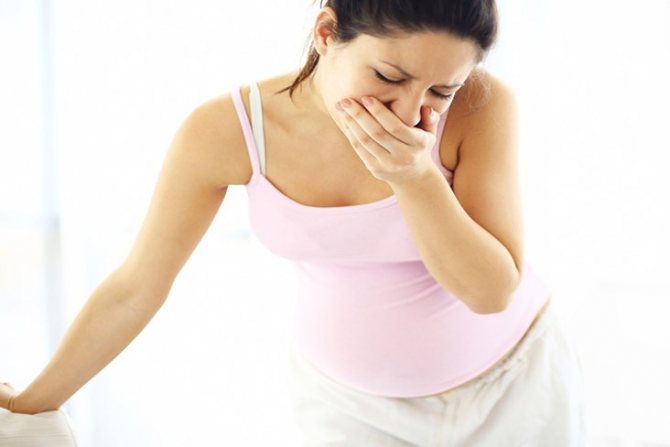
In vomit, regardless of the type and nature of vomiting, bile is always present in small quantities, which has a bitter taste after removal of gastric contents from the mouth. But if copious vomit is yellow in color and there is a pronounced bitterness in the mouth, then in this case it will be vomiting bile.
This symptom most often indicates gallbladder disease, that is, cholecystitis or the initial manifestations of pancreatitis.
Age features of the structure
In addition, a child’s gastrointestinal tract is much shorter than that of an adult and food stays in it for less time and simply does not have time to be completely digested. Pieces of food in your baby's stool may be visible to the naked eye. These can be whole vegetables, fruits, etc. And in other cases, such fragments are discovered only in laboratory conditions, during research. For example, this is how lactose deficiency is detected, in which undigested carbohydrates and lactose are found in the feces of children. The detection of whole pieces of food in a child’s stool should alert you if this is accompanied by symptoms of dyspepsia:
- loose stools;
- bloating;
- intestinal colic;
- impurities in feces (mucus, etc.).
Why there is undigested food in feces is interesting to many.
Treatment of vomiting
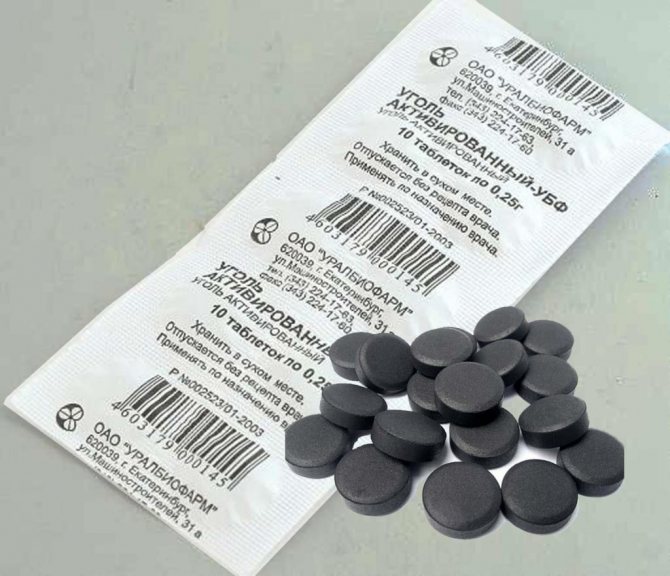
The gag reflex is a symptom of some disease. Therefore, in order for the body’s digestive system to work well, first of all, it is necessary to find out the cause of this unpleasant phenomenon and why the stomach does not accept food. Only by eliminating the cause, that is, the disease, will the functioning of the stomach be restored.
Any pathology accompanied by vomiting requires mandatory examination and treatment by a doctor. Compliance with the daily routine and diet are an integral part of the treatment process.
Depending on the pathological process causing the gag reflex, the following medications are used:
- pathology of the vestibular apparatus, accompanied by nausea and vomiting when riding in public transport or rocking at sea, can be relieved by taking Meterazine;
- food poisoning, accompanied by nausea and a gag reflex, is relieved by the use of adsorbent drugs that bind toxins that enter the body with low-quality products. The most accessible and frequently used is activated carbon;
- treatment of vomiting, which is a symptom of a disease of the stomach or intestines, is carried out comprehensively and is aimed primarily at eliminating the main cause of the pathological process;
- inflammatory processes in the body, accompanied by a gag reflex, require anti-inflammatory drug treatment prescribed by a doctor;
- The stomach's rejection of food against the background of neurotic manifestations requires treatment for neurosis, which is prescribed by a neurologist.
It must be remembered that vomiting is only a sign of some disease. Once the cause is eliminated, the symptom will also go away. You should not self-medicate with such a pathological condition of the body, so that the disease does not take a more severe form or cause complications. Only a complete examination and course of treatment prescribed by a doctor will give a positive result and prognosis.
Principles of proper nutrition
The following nutritional principles are common to all types of diets:
- products must be carefully processed: remove rough parts, films, seeds, peels, stalks;
- It is necessary to prepare food only in a certain way: steamed, boiled, baked or stewed (in no case should it be fried);
- eliminate alcohol and smoking;
- a large amount of fermented milk products enriched with lacto- and bifidobacteria is introduced into the diet;
- You need to eat small portions 5-6 times a day.
All of the above measures help eliminate the causes of undigested food in the feces of adults.
Healthy foods for digestion
Water and foods that contain proteins, fiber and complex carbohydrates have a positive effect on the functioning of the intestinal tract. Instead of sandwiches with butter and fried meat, you need to eat cereals and fruits in any form. Fermented milk products, fish and vegetables are also very useful.
Beet salad with garlic and carrots
Recipe: Boil beets and carrots. Grate on a coarse grater, season with garlic (pass through a press) and olive oil.
This salad can be served for dinner or for breakfast if you don't have to go anywhere. After all, not everyone likes the smell of garlic.
Papaya - destroys all pathogenic infections
It is very useful to eat orange pulp for heartburn, gastritis, and also for preventive purposes. The fruit helps regulate acidity levels, digest proteins and improves the absorption of beneficial components.
Associated symptoms
Short-term lientorrhea, not associated with diseases of the digestive tract or other problems, usually remains asymptomatic. Slight heaviness in the abdomen and moderate flatulence may occur.
The following signs speak in favor of pathology:
- the appearance of a sharp and unpleasant odor of feces;
- severe bloating;
- pain around the navel and in the sides of the abdomen;
- rumbling in the stomach and flatulence;
- diarrhea;
- belching;
- heartburn;
- increase in body temperature (indicates an active inflammatory process).
If any of these symptoms appear, you should consult a doctor - a therapist or gastroenterologist.
Calorie content and diets with meat
The calorie content of skinless chicken breast is 99 Kcal per 100 g. product, beef – 89 Kcal. There is also more fat in chicken meat than in beef: 1.3 g. versus 0.9 gr. No balanced diet is complete without chicken meat, but beef should also be included in the diet menu. When on a diet, the body needs positive emotions more than ever, which means you should choose between chicken and beef, taking into account your taste preferences.
It is worth summarizing that both types of meat are healthy
and should definitely be present in the diet. All that remains is to take into account the indications for use and individual preferences.
Meat is one of the main products in our diet, unless, of course, you are a vegetarian. It saturates the fastest, contains proteins, vitamins and minerals necessary for the body. Moreover, each type of meat has its own characteristics, the most important of which is the period of digestion. What meat is the worst for the body to digest?
Pieces of food in stool with diarrhea
Diarrhea is defecation that occurs more than twice a day. The stool has a liquid consistency and may contain pieces of undigested food.
Diarrhea is often accompanied by additional symptoms:
- nausea;
- discomfort in the stomach area;
- vomiting;
- bloating.
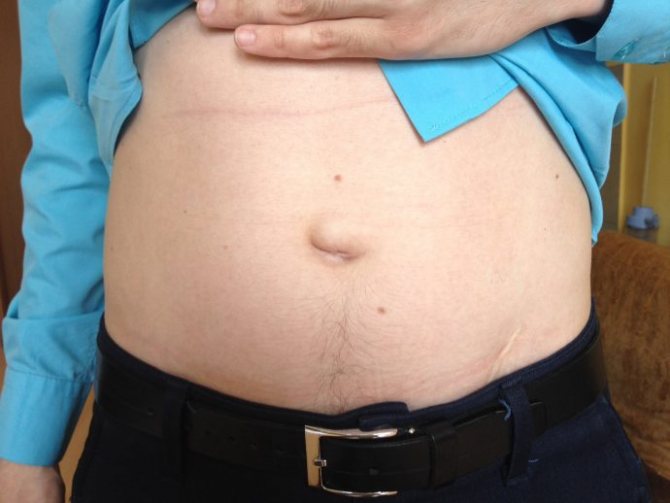
Loose stools are not normal. A pathological condition is a symptom of disturbances in the functioning of various body systems.
Diarrhea containing undigested pieces of food can occur when:
- malabsorption syndrome;
- gastritis;
- ulcer;
- enteritis;
- pancreatitis;
- hepatitis;
- Crohn's disease.
In addition to food particles, mucus may be present in the stool.
Other pathologies that occur with diarrhea are:
- food poisoning;
- disorders of the thyroid gland;
- kidney disease;
- allergic reactions;
- vitamin deficiency.
The main complication of diarrhea is dehydration. It can be fatal.
Causes of indigestion of food
People who are often worried about gastric constipation most often do not follow the principles of proper nutrition, which can lead not only to serious illness, but also to many other problems. Most often, stomach upsets occur in those who abuse food and often overeat, especially before bed. Doctors believe that the problem plagues those who eat dry food due to an active lifestyle. It is much more difficult for the organ to digest huge pieces of food, which can result in gastric atony. This is due to the fact that the organ is not able to cope with huge amounts of food.
Dental diseases, due to which all kinds of bacteria enter the gastrointestinal tract, bad habits such as smoking and systematic alcohol abuse contribute to this condition.
Atony of the stomach indicates that the muscle tone of the layers of the organ decreases, as a result of which the movement of food stops. Food that collects in the organs begins to put pressure on the walls of the stomach, thereby reducing its tone. If there are no obstacles to the normal movement of food, then gastric atony is treated with a conservative method.
Also, the reasons why the stomach does not work may be the following:
- weak secretion;
- accumulation of microorganisms on the mucous part of the organ;
- metabolic disease.
Poor secretion may be due to hormonal changes or as a result of impaired functionality of the secretory gland, which causes gastric obstruction.
As a result of atrophy, a slow process of secretion of enzymes necessary for digestion occurs. Digestion of food is significantly impaired, the mucous part becomes weak and an excellent environment for the accumulation of microorganisms is created.
If the organ does not digest food well in a small child, a psychological aspect may have influenced it: moving to another place, stopping breastfeeding, etc. This condition affects people who are physically poorly developed and regularly experience stress.
How does digestion happen?
Digestion of nutrients is an important process. With its help, the necessary microelements and vitamins enter the body. When food is digested, the necessary energy is released. The digestion process includes the following stages:
- In the mouth, food is crushed by the teeth. Saliva is released, which begins the breakdown of nutrients.
- The crushed food enters the pharynx, then the esophagus, and then into the gastrointestinal tract.
- The human stomach continues to break down nutrients. With the help of the muscular walls, food is retained in the stomach, then the gastric muscles push part of the food into the intestine.
- The glands of the mucous membrane secrete gastric juice that processes foods. The processed parts of the substances pass from the stomach to the area of the small intestine, which forms loops in the abdominal cavity. The first loop is the duodenum, connected to the liver, which secretes bile, and the pancreas, which produces pancreatic juice.
- Food elements are broken down in the cavity of the small intestine. There, the breakdown products are absorbed into the blood.
- The undigested part of the products moves from the small intestine to the large intestine, where it first accumulates and is then eliminated from the body.
Duration of absorption
Each type of product has its own digestion time. Knowing this time is important to keep your health in good shape.
Carbohydrate foods are absorbed the fastest.
With the help of knowledge you can prepare healthy and tasty dishes. Nutritionists divide foods according to digestion time into the following 4 groups:
- Carbohydrates. They have the fastest digestion speed - up to 45 minutes.
- Protein. It takes about 2 hours to digest them.
- A combination of fats and proteins. Absorption takes longer - up to 3 hours.
- Food that is poorly digested and takes a long time - from 3 hours, or does not dissolve at all and passes through the body in “transit”.
Nutrition rules
- There is no need to mix foods that take different times to digest.
- Food should be chewed, crushed and treated with salivary enzymes.
- It is important what temperature the food is. The gastrointestinal tract processes cold food faster, absorption is impaired, and hunger appears faster.
- When adding fats and oils, the duration of digestion increases by 2.5-3 hours.
- Boiled and fried products lose some beneficial properties due to heat treatment; the stomach works 1.5 times longer.
- If the food has not yet been digested, adding liquid reduces the content of gastric juice.
- When drinking water on an empty stomach, it immediately enters the intestines.
- At night, the body, including the gastrointestinal tract, rests, so evening foods are digested in the morning.
Stomach does not accept food, causes vomiting. Vomiting after eating: causes and treatment
Nausea after eating in an adult is most often a sign of a gastrointestinal disease (chronic or acute).
This condition occurs if a person suffering from gastritis or pancreatitis has eaten fatty, fried, spicy foods. This can also occur if the liver is not functioning properly. One of the most common causes of vomiting after eating in adults is alcohol abuse during lunch or dinner.
If the digestive system malfunctions, a person experiences accompanying symptoms:
- sharp or nagging pain in the abdomen;
- severe belching;
- feeling of heaviness in the stomach;
- bloating;
- unpleasant taste in the mouth;
- frequent hiccups;
- deterioration of appetite (a person will eat a minimum amount of food);
- increased thirst;
- nausea and vomiting;
- bowel dysfunction, diarrhea will be replaced by prolonged constipation.
Sometimes this condition is accompanied by increased body temperature, general weakness and dizziness.
If the stomach is stuck, it is better not to take measures in the first hours, but to give the organ the opportunity to recover on its own. Sometimes 2 hours is enough to regulate activity and digest a large amount of food received. If there is no positive result, you need to contact a qualified doctor, otherwise the situation will worsen.
In case of intoxication or consumption of low-quality products, the following tips will help to start the stomach after poisoning:
- You need to drink at least one and a half liters of filtered water per day.
- Meals are taken at least 5 times a day, portions should be small.
- 20 minutes before meals you need to drink 200 ml of water. Then you can drink only an hour after eating.
- The optimal food on the first day is white bread crackers, oatmeal or rice porridge, boiled in water.
It is strictly forbidden to eat fatty and fried foods, as well as pickles and smoked foods. To restore gastric peristalsis faster, you can take medications aimed at restoring the mucous membrane as adjuncts.
Vomiting is a fairly common condition in children in which food and liquid from the stomach are thrown back through the mouth and nose. Vomiting is not an independent disease, it is always a symptom, and is often accompanied by other manifestations of the disease: diarrhea, fever, headache. But in some cases, a child may vomit without fever or other symptoms.
Causes of vomiting without fever
Vomiting that is not accompanied by a fever may have several causes. For convenience of consideration, they can be divided into three groups.
Discomfort in the area of the stomach and esophagus is called nausea, which causes a lot of inconvenience to a person. Situations are common when you feel sick after eating, which means that eating your favorite foods is overshadowed by a physiological disorder. Having studied the reasons for the appearance of vomiting, a citizen is able to identify the initiator that affects the appearance of nausea after eating.
Nausea as a sign of illness
Improper functioning of some organs provokes the appearance of uncomfortable conditions. Most often, nausea is caused by disorders of the digestive tract, but neurological and endocrine disorders can also be the initiators.
Ulcerative lesions. The inflammatory process occurring in the gastrointestinal tract leads to heaviness in the stomach and a feeling of fullness. Nausea with ulcers actively manifests itself after a violation of the dietary regime.
- 1Basic information about the disease
- 2Causes of the disease
- 3Types and forms of the disease
- 4Diagnostic methods
- 5Therapeutic measures
1Basic information about the disease
The stomach is the place where food is digested. Its volume in an adult is approximately 2-3 liters.
Food enters the stomach through the esophagus, where it is broken down into its components: proteins, carbohydrates and fats. When the body feels the need for food, it gives a signal and the amount of hydrochloric acid increases, which helps break down food.
The speed of this process is different: carbohydrates are completely processed in 2 hours, while a similar process for fats takes up to 5 hours.
The deterioration of the stomach, in which it practically stops digesting food, is called dyspepsia and can be accompanied by unpleasant sensations: attacks of nausea, heaviness in the stomach and a feeling of fullness. If timely effective measures are not taken, the consequences will be very serious.
What pills should I take?
1. Every home should have No-spa, activated carbon or Smecta, propolis tincture, herbal tea based on chamomile and mint. These are safe means to relieve spasms, relieve pain, relieve intoxication, and stop diarrhea.
2. Sunflower oil, washed down with warm tea, will protect the organ irritated after heavy drinking from the effects of acids.
3. For constipation and flatulence, you should take Espumisan.
4. Heartburn and diarrhea are a symptom of gastritis with high acidity. Antacids, for example, Gastal, will help relieve it and the accompanying pain.
5. Belching with the smell of rotten eggs, constipation, heaviness - evidence of gastritis with low acidity or temporary inhibition of the digestive glands. Treatment is usually carried out with enzyme preparations, such as Festal, but for severe pain it is better to take drugs to enhance peristalsis, for example, Motilium.
Treatment of gastritis
The most common reason why the stomach hurts after drinking alcohol in healthy young people is the development of alcoholic gastritis. This disease progresses with frequent drinking of alcohol (more than once a day) for a long time, and its symptoms are similar to other types of gastritis.
The main difference between alcoholic gastritis is a decrease in manifestations during repeated intoxication, the so-called hangover. After binge drinking, it can take an acute or chronic form.
The initial stage of alcoholic gastritis is not accompanied by inflammation of the mucous membrane, limited to erosion - the destroyed state of the epithelial layer. If the attack is mild, you can try to cure the onset of gastritis at home. For this:
- completely abstain from alcohol during treatment;
- quit smoking;
- avoid stress;
- switch to multiple meals on a schedule, chew food thoroughly;
- go on a diet - exclude fried, smoked, salted, spicy, hot foods; for the first 2-3 weeks, eat only ground and heated foods.
Useful tips
That is why a person must treat his health with due respect and, if possible, prevent his well-being from deteriorating. One of the most important human organs is the stomach, because it is this organ that, to one degree or another, supports the full functioning of a person.
Stomach arrest (in medicine, atony) is a rather serious and unpleasant disease, which in our time, unfortunately, has begun to appear more and more often. It should also be noted that atony occurs in both adults and children. There are many reasons for the manifestation of this disease, let’s consider the main ones:
- Poor nutrition
- Excessive alcohol consumption
- Smoking
- Stress
- Fast weight loss
- Frequent overwork
- Severe exhaustion of a person
- Previous anesthesia
- Diseases of the abdominal organs
- Increased anxiety
- Various infections
The main reason for stomach failure is probably poor nutrition. The pace of life of a modern person is truly crazy.
Living in such a rhythm, people simply cannot take proper care of their nutrition:
- quick snacks
- eating fatty and spicy foods
- Frequent overeating is the first step to problems with the gastrointestinal tract
Based on the fact that when the stomach stops, the pain is quite strong, you should act immediately. It depends on how quickly and correctly the actions are taken whether the result will be achieved and whether more professional help will be required.
You can relieve abdominal pain and improve your general condition accordingly with specific medications. So, when your stomach stops, you need to look for the following in your first aid kit:
- Activated carbon
- Mezim
- Pancreatin
- Drotaverine
- Creon
- Festal
- Somilazu
Medicines for the stomach
Now let's take a closer look at each medication:
- Pancreatin is one of the best drugs prescribed to improve digestion. When the stomach stops, an adult needs to take 2-3 tablets; for children, 1 piece will be enough. It is recommended to take the tablets with meals, without chewing them and drinking plenty of water.
- Mezim, Creon, Festal are analogues of pancreatin: therefore, if you don’t find it in your medicine cabinet, you can safely replace it with these drugs. The method of administration and dosage are also similar to the drug Pancreatin.
- Activated carbon should be taken at the rate of 1 tablet per 10 kg of body weight.
- Adults should take Somilase 1-2 tablets during meals with plenty of water.
- The well-known nosh-pa or its analogue, drotaverine, is perfect for relieving spasms. To do this, an adult needs to take 1-2 tablets, while a child will need one.
To improve the effect when the stomach stops, you can drink activated charcoal, drotaverine and mezim together in the indicated dosages - this will be the first aid for atony.
Pancreatin, mezim, festal are strictly prohibited for people who have:
- Jaundice
- Pancreatitis
- Diabetes
- Hepatitis
- Acute forms of gastritis
It is also worth paying attention to the fact that if you have made a choice in favor of solving the problem at home and have taken the above-mentioned medications, but the desired result has not been achieved, you should urgently consult a doctor. Extra precautions should also be taken when it comes to children.
We have successfully dealt with the medicinal part of providing assistance, but we should not forget about the opportunity to help ourselves in other ways.
Source: https://probol.info/otravleniya/zheludok-ne-prinimaet-pishhu-rvota-prichiny-rvota-posle-edy-prichiny-i-lechenie.html
Causes of poor digestion of food
When food is not digested in the stomach often enough,
the reasons may lie in an incorrectly structured diet and menu selection. Usually, dyspepsia is characteristic of those who eat uncontrollably, overeating and eating just before going to bed. An active lifestyle can also cause unpleasant sensations - by rushing and swallowing food on the go, a person himself makes it difficult for his stomach, because it is much more difficult to digest large pieces. The result of such a diet is often atony, the development of which is also facilitated by diseases of the oral cavity, when there is an active entry of bacteria into the digestive system, bad habits, and constant abuse of alcohol-containing drinks.
Development of atony
- a signal that the muscle tone of the organ is deteriorating, which leads to a stop in the movement of food. When it accumulates, pressure on the gastric walls increases, which further reduces the tone. In cases where there are no obstacles preventing the movement of food through the digestive system, atony can be treated conservatively. If we consider other reasons why food is not digested in the stomach, we can indicate:
- Insufficient secretion production
under the influence of hormonal changes or due to impaired functioning of the secretory gland. As a result, gastric obstruction may develop. - The accumulation of harmful microorganisms
on the gastric mucous layer becomes possible with atrophy. The enzymes required for quality digestion are not released at the required speed, the stomach does not digest food well, and the mucous membranes are weakened, which creates an excellent environment for microorganisms. - Disturbed metabolic processes.
- Psychological factors
are also important; they affect patients whose physical fitness leaves much to be desired, and people constantly experiencing stress. Babies can also be included in this category, since their emotional state is unstable and can change negatively under the influence of many factors, from moving to stopping breastfeeding.
How to prevent the problem?
It is necessary to make changes to your usual diet by adding to each meal
plants containing dietary fiber, except those that your intestines cannot tolerate. Apples, cabbage and legumes are definitely better not to try. Proper food must be chewed thoroughly.
The process of forming a new diet will not be quick, since finding suitable products is not an easy task in the context of the widespread abundance of refined food. But you can easily get rid of increased gas formation in the intestines (flatulence) simply by adding the right dietary fiber to your diet.
If any food causes vomiting, this indicates a disturbance in the functioning of the stomach. Malaise can be due to various reasons, including:
All reasons can be quite serious. Only a doctor can deal with them after an examination.
Why do you feel sick after eating? Causes and treatment
Many people ask the question: “Why do you feel sick after eating and what are the additional symptoms of diseases that cause nausea?” You need to know the answers to these questions in order to seek medical help in time and begin treatment.
It is important to remember that nausea after eating is not an independent pathology, but only a sign of various, sometimes very dangerous diseases that require mandatory treatment.
But before we start, please like and subscribe to the channel.
Thank you!
Causes of nausea after eating
A person may feel sick after eating in a number of pathologies and non-pathological conditions.
The main factors influencing the occurrence of nausea include:
- Diseases of the digestive system.
- Intestinal infections, food poisoning.
- Violation of diet and diet.
- Disorders of the vestibular apparatus.
- Toxicosis during pregnancy.
- Liver diseases.
- Helminthiasis.
- Myocardial infarction.
- Attack of appendicitis.
- Side effects when taking certain medications, drug overdose.
Diseases of the digestive system
Nausea is one of the symptoms of gastrointestinal diseases
, such as:
- gastritis;
- duodenitis;
- peptic ulcer;
- pancreatitis.
Gastritis is the most common stomach disease
and is characterized by inflammation of its mucous membrane. The development of gastritis is described as acute and rapid. The patient notes that there is no appetite, nausea appears after eating any food.
There is also profuse vomiting, belching with the smell of hydrogen sulfide, and increased salivation. Acute gastritis is always accompanied by pain and heaviness in the pit of the stomach. There is a loss of strength, weakness, flatulence, and increased heart rate.
Gastritis is treated with medications and diet.
Duodenitis
– inflammatory disease of the duodenal mucosa, which is characterized by
the following clinical signs:
- mild nausea and vomiting after (sometimes during) meals;
- feeling of fullness in the upper abdomen;
- soreness in the center of the chest;
- heartburn;
- increased gas formation;
- decreased appetite or complete absence of it.
Treatment of duodenitis depends on its clinical form. As a rule, drug therapy and diet treatment are carried out. In some cases, physiotherapy and surgical intervention are indicated.
The person notes that the nausea goes away briefly each time he vomits. Therefore, many people artificially (and mistakenly) induce vomiting every time, which leads to aggravation of the situation.
Ulcer of the stomach and duodenum
– a pathology characterized by the presence of a persistent defect on the mucous membrane of organs, which involves all tissues, including muscle.
In addition to nausea after eating (which appears an hour or 2 hours after each meal), the pathology manifests itself with the following symptoms:
- heaviness and feeling of fullness in the stomach;
- feeling of abdominal distension;
- vomiting;
- appetite disorder;
- sudden weight loss;
- burning sensation in the esophagus.
Treatment uses medications, physiotherapy and diet. In case of perforation of the ulcer, emergency surgical treatment is resorted to.
Pancreatitis
– an inflammatory disease of the gallbladder, which is characterized by an acute and chronic course. The disease is accompanied by nausea, flatulence, acute pain in the abdomen, radiating to the right hypochondrium and back, stool disorder and a sharp decrease in body weight. Treatment is carried out with dietary changes and medications.
_____________________________________________________________________________________
The NetGastritu project was created with the goal of providing people with accurate and up-to-date information on medical topics. Articles are written by professionals and, unfortunately, development costs slow down the development of the project. If you want to support us, use the form below. Let's make the world a better place together. Thank you for your attention.
_____________________________________________________________________________________
Intestinal infections and food poisoning
In these conditions, nausea appears some time after eating low-quality food and always ends with profuse vomiting. It is when a person vomits that the body removes the intoxicating source.
Along with nausea and vomiting, diarrhea may also appear. Intoxication causes general weakness, headache and muscle pain, and fever.
If the necessary measures are not taken, after 24-48 hours the patient will begin to show signs of dehydration, such as:
- feeling of thirst;
- dryness of mucous membranes and skin;
- vertigo;
- impaired urination (decreased or absent);
- weight loss.
Treatment boils down to taking adsorbent drugs and drinking large amounts of fluid.
Important: if signs of intoxication increase (increased nausea, weakness), as well as if a child is poisoned, it is necessary to urgently call an ambulance.
Eating disorder
Violation of the diet and regime means overeating (even once), eating too fatty foods and sweet foods (halva, fried foods, etc.), eating fried foods, fasting, etc. Also, unpleasant symptoms in the form of nausea, bloating and pain appear when long breaks between meals.
Severe nausea occurs when following diets, such as mono diets, extreme diets. In this case, you may feel sick both before eating and when you eat.
Toxicosis
Toxicosis is a very common condition in women during pregnancy, which is manifested by constant nausea, a woman feels like vomiting, especially after eating (often immediately after a woman has eaten fatty foods).
The development of toxicosis is associated with poisoning of the pregnant woman’s body with substances that are formed during the development of the fetus.
Toxicosis is characteristic of early pregnancy. The woman feels a deterioration in her health, a strong negative reaction to smells and food, and nausea.
You can get rid of the manifestations of toxicosis by including fruits and nuts, as well as crackers, in the pregnant woman’s diet in the morning.
Preeclampsia, also known as late-stage toxicosis, is a pathological process that requires mandatory hospital treatment. Late toxicosis indicates damage to a woman’s urinary and nervous systems.
Liver diseases
One of the symptoms of pathologies of the liver and biliary tract is a feeling of nausea, including after eating.
Nausea is typical for hepatitis, cirrhosis, cholecystitis, cholangitis, etc.
https://www.youtube.com/watch?v=xSDQ_A42yNw
With these pathologies, constant severe nausea is accompanied by pain in the right side, and the skin and sclera of the eyes become yellow. Additionally, belching of air, bitterness in the mouth, and bloating are noted. Profuse vomiting may occur, often with bile.
Treatment is prescribed exclusively by a doctor, based on examination data and symptoms. As a rule, drug therapy is used.
Helminthiasis
Another reason why a person feels sick after eating is infection of his body with helminths.
Additionally, helminthiasis manifests itself:
- bloating;
- stool disorder;
- itching of the anus, especially in the evening;
- neuroses;
- anemia.
Very often, adults and children experience stomach pain when infected with parasites.
Important: helminthic infestation is often confused with gastrointestinal pathologies. For this reason, self-treatment is unacceptable, as it can cause serious complications.
Myocardial infarction
Nausea in patients over 50 years of age or patients at risk (smokers, overweight people) may be a symptom of myocardial infarction - an acute disruption of the blood supply to the heart muscle due to thrombosis of one of the heart arteries
.
Typical signs of pathology include acute chest pain radiating to the left arm, neck, and lower jaw on the left. In the atypical course of the pathology, severe coughing, circulatory disorders (cold extremities, pale skin), and pulse irregularities (arrhythmia) are noted.
Important: heart attack is a condition that can cause death, so at the first sign you must call an ambulance.
Appendicitis
An acute condition characterized by inflammation of the appendix.
The main sign of inflammation is acute, increasing pain, which at the very beginning does not have a clear localization and is spread throughout the abdomen.
Further, the pain is localized in the right lower abdomen and intensifies with movement. Along with the pain syndrome, nausea (sometimes slight nausea), upset stool, vomiting, and dyspepsia occur.
Treatment of pathology is strictly surgical.
Important: lack of treatment leads to rupture of the appendix, the development of peritonitis and sepsis and the inevitable death of a person. If symptoms appear, emergency hospitalization is necessary.
Problems with the vestibular system
Nausea after eating can occur, for example, if you take a horizontal position after eating or suddenly get up from the table. Disorders of this nature are accompanied by loss of balance, dizziness, tinnitus, and visual disturbances.
In order to alleviate the condition a little, experts advise drinking lemon juice during an attack.
Side effects and drug overdose
When taking certain medications, unwanted effects may occur, including nausea. Sometimes the side effects of medications are temporary and do not require discontinuation, but in some cases it is necessary to consult a doctor to discontinue or replace the medication.
The main symptom of a drug overdose is also nausea and vomiting. In this case, it is necessary to call an ambulance before drug poisoning causes irreparable harm to health. To treat an overdose, gastric lavage and symptomatic therapy are indicated.
Other causes of nausea after eating in women and men
- Hypertension
is a disease that is expressed by increased blood pressure. Patients feel nauseous in the morning, experience fatigue, drowsiness during the day, swelling and redness of the face in the morning. Treatment of hypertension is medication, most often lifelong. - Hypothyroidism
– a pathology caused by a deficiency of thyroid hormones due to various reasons. Treatment depends on the disease causing the hormone deficiency.As a rule, we are talking about drug replacement therapy, but it happens that surgical intervention on the gland is necessary.
- Kidney inflammation
. The condition is characterized by fever to febrile, nausea and vomiting.The main symptom is pain of various types in the lower back and abdomen and dysfunction of the urinary system.
– Nausea: causes, symptoms
As you can see, there are many reasons why you may feel sick after eating. Some of the conditions and diseases pose a danger to human life.
This symptom cannot be ignored, since timely treatment begins not only to prevent the disease from developing, but also to save life.
It is best to immediately consult a doctor, who will determine what to do if a person feels sick.
Let's like and subscribe to the channel. Thank you for your attention!
